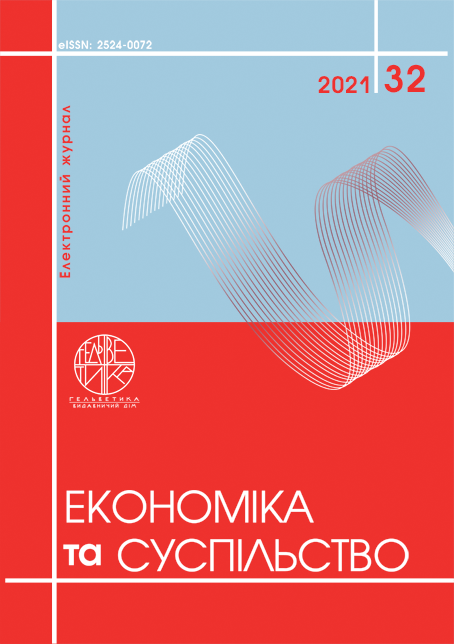USE OF NORMAL DISTRIBUTION IN QUALITY MANAGEMENT IN APPAREL AND FOOTWEAR INDUSTRY ENTERPRISES
Abstract
The article proposes approaches to the use of statistical methods in quality management in the garment and footwear industries, which ensures the correct collection, quantitative analysis of information and qualitative interpretation of the results. In the context of globalization of the world economy, the importance of developing approaches to the collection of statistical information is growing. The entry of the enterprises of the garment and footwear industry of Ukraine on the world markets under its own brand requires knowledge and information about the consumers of the global market. Consumers in different markets around the world may differ in anthropometric size. The enterprise of garment and footwear industry in mass production requires knowledge of various human anthropometric indicators, the main of which are the linear dimensions of the body in order to develop the optimal size and complete range of clothing and footwear. It is possible to study consumers in this case on the basis of use of statistical methods. World experience shows that high quality products have been achieved by enterprises and organizations that have used statistical methods of quality management. To form the optimal size and complete range of fashion products, it is proposed to use a normal distribution. Normal distribution is the most important distribution for continuous random variables - quantities whose possible values continuously fill some interval on the numerical axis of real values. Metric sizes of fashion products are continuous values. Due to the impact of various factors, the quality mark can take on different meanings. The exact meaning that the sign can acquire is unknown and is random under the influence of variation. Acquisition of a sign of some values is more frequent than others, ie the appearance of certain values is more likely than the appearance of others. The practical value of the study lies in the possibility of using the normal distribution to form the optimal size and complete range of light industry products, as demonstrated by the example of determining the percentage of women who have standard and non-standard height.
References
Бондаренко С.М., Касич А.О. Використання концепції загального управління якістю (TQM) в органах місцевого самоврядування. Державне управління: удосконалення та розвиток. 2017. № 2. URL: http://www.dy.nayka.com.ua/?op=1&z=1029
Бондаренко С.М. Ділова досконалість підприємств як фактор конкурентоспроможності національної економіки України. Економічний простір. 2016. № 116. С. 200–208.
Бондаренко С.М. Використання біноміального розподілу в управлінні якістю на підприємстві. Ефективна економіка. 2019. № 9. URL: http://www.economy.nayka.com.ua/?op=1&z=7272
Бондаренко С.М. Використання розподілу Пуассона в системі управління якістю на підприємстві. Причорноморські економічні студії. 2020. Випуск 58–1. С. 108–112.
ДСТУ ISO 9000:2015 Системи управління якістю. Основні положення та словник термінів. (ISO 9000:2015 IDT). Київ : ДП «УкрНДНЦ», 2016. 45 с.
ДСТУ ISO 9001:2015 Системи управління якістю. Вимоги. (ISO 9001:2015 IDT). Київ : ДП «УкрНДНЦ», 2016. 21 с.
Захожай В.Б., Чорний А.Ю. Статистика якості. Київ : МАУП, 2005. 576 с.
Касич А.О., Харькова Ж.В. Управління конкурентними перевагами підприємства. Економічний аналіз. 2016. № 2. С. 79–85.
Статистические методы управления качеством. Київ : Украинская ассоциация качества. Прирост-Академия, 2007. 129 с.
Цалко Т.Р., Невмержицька С.М. Система ключових показників ефективності як запорука ефективного управління бізнес-процесами в компанії. Проблеми системного підходу в економіці. 2019. Випуск № 6 (74). С. 160–167.
Bondarenko S.M., Kasych A.O. (2017) Vykorystannia kontseptsii zahalnoho upravlinnia yakistiu (TQM) v orhanakh mistsevoho samovriaduvannia [Use of the concept of total quality management (TQM) in local governments]. Derzhavne upravlinnia: udoskonalennia ta rozvytok, no. 2. Retrieved from: http://www.dy.nayka.com.ua/?op=1&z=1029 (in Ukrainian)
Bondarenko S.M. (2016) Dilova doskonalistj pidpryjemstv jak faktor konkurentospromozhnosti nacionaljnoji ekonomiky Ukrajiny [Business excellence of enterprises as a factor of competitiveness of the national economy of Ukraine]. Ekonomichnyj prostir, no. 116, pp. 200–208. (in Ukrainian)
Bondarenko S.M. (2019) Vykorystannya binomialnogo rozpodilu v upravlinni yakistyu na pidpryyemstvi [Use of Binomial distribution in quality management at the enterprise]. Efektyvna ekonomika, no. 9. Retrieved from: http://www.economy.nayka.com.ua/?op=1&z=7272 (in Ukrainian)
Bondarenko S.M. (2020) Vykorystannia rozpodilu Puassona v systemi upravlinnia yakistiu na pidpryiemstvi [The use of the Poisson distribution in the quality management system in the enterprise]. Prychornomorski ekonomichni studii, vol. 58–1, pp. 108–112. Retrieved from: http://bses.in.ua/journals/2020/58_1_2020/20.pdf (in Ukrainian)
UkrNDNTs (2016) DSTU ISO 9000:2015 Systemy upravlinnia iakistiu. Osnovni polozhennia ta slovnyk terminiv [Quality management systems. Basic provisions and glossary of terms]. Кyiv : UkrNDNTs. (in Ukrainian)
UkrNDNTs (2016) DSTU ISO 9001:2015 Systemy upravlinnia iakistiu. Vymohy [Quality management systems. Requirements]. Кyiv : UkrNDNTs. (in Ukrainian)
Zaxozhaj V.B., Chornyj A.Yu. (2005) Statystyka yakosti. [Quality statistics]. Kyiv : MAUP (in Ukrainian)
Kasych A.O., Kharkova Zh.V. (2016) Upravlinnya konkurentnymy perevagamy pidpryyemstva [Management of competitive advantages of the enterprise]. Ekonomichnyj analiz, no. 2, pp. 79–85. Retrieved from: https://www.econa.org.ua/index.php/econa/article/view/1212/970 (in Ukrainian)
Ukrainskaja asociacija kachestva (2007) Statisticheskie metody upravlenija kachestvom. [Statistical methods of quality management]. Kyiv : Ukrainskaja asociacija kachestva. Prirost-Akademija. (in Ukrainian)
Tsalko T.R., Nevmerzhytska S.M. (2019) Systema kliuchovykh pokaznykiv efektyvnosti yak zaporuka efektyvnoho upravlinnia biznes-protsesamy v kompanii. Problemy systemnoho pidkhodu v ekonomits, vol. 6 (74), pp. 160–167. Retrieved from: http://psae-jrnl.nau.in.ua/journal/6_74_2_2019_ukr/21.pdf (in Ukrainian)


